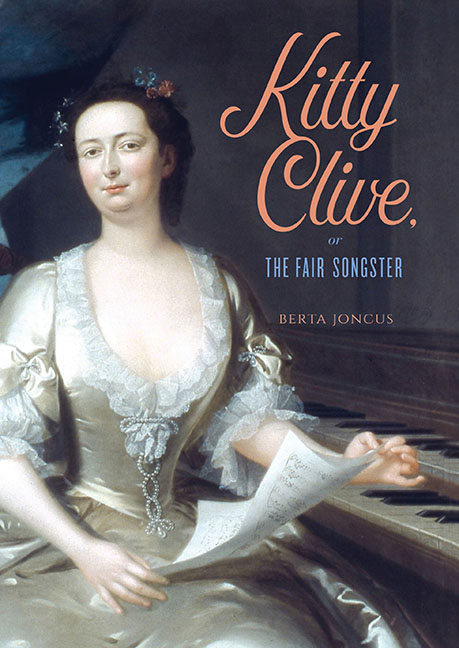Book contents
- Frontmatter
- Dedication
- Contents
- Illustrations
- Preface
- Conventions of Transcription
- 1 The Siren Song: Kitty Clive in the Playhouse
- 2 ‘The Lovely Virgin tun'd her Voice’: Henry Carey and the Production of a Native Songster
- 3 ‘Charm'd with the sprightly Innocence of Nell’: The Metamorphosis of Miss Raftor
- 4 ‘HINT writes, and RAFTOR acts in Drury-lane’: Clive, Fielding, and Theophilus Cibber
- 5 ‘The pious Daughter, and the faithful Wife’: Fielding, Miller, and Clive, 1733–35
- 6 ‘A Likeness where none was to be found’: Contested Images of Clive, 1734–37
- 7 The Patriot Soprano: British Worthies at Drury Lane
- 8 Handel and the Sweet Bird of Drury Lane, 1740–43
- 9 The Case of Mrs. Clive
- 10 Of Scuffles and Rivalries: The Demise of ‘Kitty Cuckoe’
- 11 From Miss Lucy to Mrs. Riot: Voice and Caricature
- 12 Clive on Clive: The Rehearsal: Or, Bays in Petticoats
- 13 Conclusion: The Fair Songster
- Appendix 1 Catherine Clive's Roles 1728–69
- Appendix 2 Lines in Catherine Clive's Repertory 1728–69
- Appendix 3 The Case of Mrs. CLIVE (1744)
- Select Bibliography
- Index
1 - The Siren Song: Kitty Clive in the Playhouse
Published online by Cambridge University Press: 20 September 2019
- Frontmatter
- Dedication
- Contents
- Illustrations
- Preface
- Conventions of Transcription
- 1 The Siren Song: Kitty Clive in the Playhouse
- 2 ‘The Lovely Virgin tun'd her Voice’: Henry Carey and the Production of a Native Songster
- 3 ‘Charm'd with the sprightly Innocence of Nell’: The Metamorphosis of Miss Raftor
- 4 ‘HINT writes, and RAFTOR acts in Drury-lane’: Clive, Fielding, and Theophilus Cibber
- 5 ‘The pious Daughter, and the faithful Wife’: Fielding, Miller, and Clive, 1733–35
- 6 ‘A Likeness where none was to be found’: Contested Images of Clive, 1734–37
- 7 The Patriot Soprano: British Worthies at Drury Lane
- 8 Handel and the Sweet Bird of Drury Lane, 1740–43
- 9 The Case of Mrs. Clive
- 10 Of Scuffles and Rivalries: The Demise of ‘Kitty Cuckoe’
- 11 From Miss Lucy to Mrs. Riot: Voice and Caricature
- 12 Clive on Clive: The Rehearsal: Or, Bays in Petticoats
- 13 Conclusion: The Fair Songster
- Appendix 1 Catherine Clive's Roles 1728–69
- Appendix 2 Lines in Catherine Clive's Repertory 1728–69
- Appendix 3 The Case of Mrs. CLIVE (1744)
- Select Bibliography
- Index
Summary
If therefore this Theatrical Genius was able to entertain, contrary to the Intention of the Author – what must we say of her, or what Words can describe her Merits, when she appeared in the Fulness of her Powers, and was the very Person she represented?
Benjamin Victor on Catherine Clive, The History of the Theatres of London, from the Year 1760 to the Present Time (London, 1771), vol. 3, p. 145.
Who was Kitty Clive? Her earliest ‘portrait’ shows a bare-bosomed nymph whose song, verses below the image tell us, seduces male listeners. Like so many representations of Clive, this image was a fiction; it was taken from a canvas painted c.1695, sixteen years before she was born. Stories were spun around Clive, some of them by Clive herself. She asserted the kind of person she was through performance, which was when she had greatest control over her self-presentation. Audiences knew that what she enacted was a show, with postures and antics, but soaring above this noise was her seemingly incorruptible voice, which fascinated them. Clive became the first playhouse principal to attain and maintain stardom primarily through song.
Her ascent was improbable. She was born Catherine Raftor, to William and Elizabeth Raftor, in London in 1711.1 She once suggested that her birthday was 15 November, but her twentieth-century biographer Patrick J. Crean found evidence that she may have been baptized ‘Ellenor’ on 15 July 1711. Her father was the son of dispossessed Catholic Anglo-Irish landowners. Disgraced through his support of the Stuart King James II, William Raftor was on 21 April 1691 listed as one of the ‘Jacobites of the County Kilkenny and Upper Ossory[,] outlawed’ by England's new monarch, King William. After the Crown expropriated his lands, he fled to France, like many of his compatriots. He sued for and was granted pardon, came to London, and married Elizabeth Daniell, daughter of ‘an eminent Leather-seller … with whom he had a handsome Fortune’. William Raftor was trained in law but as a Catholic was unable to practise his profession in London.
- Type
- Chapter
- Information
- Kitty Clive, or the Fair Songster , pp. 1 - 27Publisher: Boydell & BrewerPrint publication year: 2019

